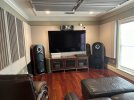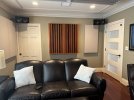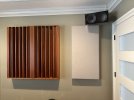I’ve been looking for a center channel that would work with my TAD R1s for some time. TAD made a few prototypes, but never commercialized them. The closest commercial product was the Pioneer S7 EX that used TAD drivers, but these are long discontinued.
But when KEF offered their Reference 2C at 50% off, I decided to give it a try, and I also got their R3 Meta as surround and their R8 Meta as height speakers. When I first cranked the system up, it sounded OK but each speaker stood out with its own timbre. Then I ran a Dirac calibration on my Denon 4800H that I’m using as a pre-pro. This made a huge difference. The system sounds like an IMAX theater and the timbre is uniform across all the speakers.
The R1s are flat to 17hz in my room, so there is no need for a sub. The Denon does a brilliant job sending the LFE to the TADs, and it also allows each small speaker to have each own crossover point. I set the Reference 2C at 60hz, the R3 Meta surrounds at 80hz and the R8 Meta heights a 150hz.
All amps are Benchmark, except for the height channels that use the Denon. Three front channels have bridged mono amps.
I suspect what makes this work so well is that all the speakers use a coax mid/tweeter driver, so they all behave similarly and with judiciously applied EQ they match quite nicely. The Reference KEF speakers also share very low distortion measurements, comparable to the TADs.
But when KEF offered their Reference 2C at 50% off, I decided to give it a try, and I also got their R3 Meta as surround and their R8 Meta as height speakers. When I first cranked the system up, it sounded OK but each speaker stood out with its own timbre. Then I ran a Dirac calibration on my Denon 4800H that I’m using as a pre-pro. This made a huge difference. The system sounds like an IMAX theater and the timbre is uniform across all the speakers.
The R1s are flat to 17hz in my room, so there is no need for a sub. The Denon does a brilliant job sending the LFE to the TADs, and it also allows each small speaker to have each own crossover point. I set the Reference 2C at 60hz, the R3 Meta surrounds at 80hz and the R8 Meta heights a 150hz.
All amps are Benchmark, except for the height channels that use the Denon. Three front channels have bridged mono amps.
I suspect what makes this work so well is that all the speakers use a coax mid/tweeter driver, so they all behave similarly and with judiciously applied EQ they match quite nicely. The Reference KEF speakers also share very low distortion measurements, comparable to the TADs.



